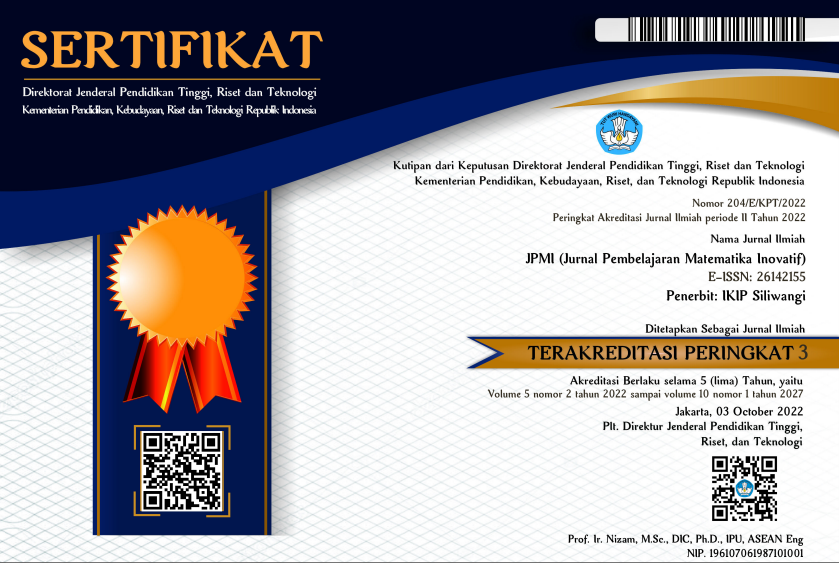Pengaruh penggunaan media pembelajaran materi statistika menggunakan pendekatan saintifik berbantuan scratch terhadap kemampuan pemahaman matematis siswa SMP
DOI:
https://doi.org/10.22460/jpmi.v6i5.20751Keywords:
Learning media , Statistics Scientific approach , Scratch, Mathematical understandingAbstract
This research was motivated by junior high school students lack of interest in learning mathematics subjetcs, so their mathematical understanding abilities tend to be low. The aim of this research was to find out how much influence the use of statistical material learning media using a Scratch-assisted scientific approach has on the mathematical understanding abilities of junior high school students. The subjects in this research were 26 class VIII students at SMP Negeri 15 Cimahi who were selected using a purposive sampling technique. In this research, the method used was an experimental method with a one group pretest-posttest design. Meanwhile, the data analysis technique used is quantitative descriptive which is then processed using Microsoft Excel 2013. After the test was carried out, there was an increase in the students average score. Before reciving treatment, the average learning outcome was 46,15, after reciving treatment, the average increased to 86,15. Apart from that, the number of students whose scores reached the KKM also increased. This proves that the use of Scratch-assisted learning media in statistics material has a great influence on junior high school students mathematical understanding abilities.
References
Fajriah, N., Utami, C., & Mariyam. (2020). Analisis kemampuan representasi matematis siswa pada materi penyajian data. JERR : Journal of Educational Review and Research, 3(1), 14–24. https://doi.org/10.55606/jurrimipa.v1i1.160
Haque, Z. U., & Kurniawan, R. Y. (2021). Pengembangan bahan ajar ekonomi berbasis problem based learning dalam bentuk buku saku digital. Edunomic Jurnal Pendidikan Ekonomi, 9(1), 56–68. https://doi.org/10.33603/ejpe.v9i1.4620
Hendriana, H., Rohaeti, E. E., & Sumarmo, U. (2017). Hard skills dan soft skills matematik siswa (N. F. Atif (ed.); 1st ed.). Refika Aditama.
Kusmaryono, I. (2014). The importance of mathematical power in mathematics learning. International Conference on Mathematics, Science, and Education, 10(7), 35–40.
Lenaini, I. (2021). Teknik pengambilan sampel purposive dan snowball sampling. Jurnal Kajian, Penelitian & Pengembangan Pendidikan Sejarah, 6(1), 33–39. https://doi.org/https://doi.org/10.31764/historis.v6i1.4075
Lenggogeni, L., & Roqoyyah, S. (2021). Penggunaan media video animasi berbantuan Scratch melalui model pembelajaran picture and picture terhadap kemampuan berfikir kreatif siswa pada mata pelajaran IPA materi daur hidup hewan kelas IV. Journal of Elementary Education, 04(02), 249–256. https://doi.org/https://doi.org/10.22460/collase.v4i2.5687
Maharani, S., & Bernard, M. (2018). Analisis hubungan resiliensi matematik terhadap kemampuan pemecahan masalah siswa pada materi lingkaran. JPMI (Jurnal Pembelajaran Matematika Inovatif), 1(5), 819–826. https://doi.org/10.22460/jpmi.v1i5.p819-826
Martanti, A. P., Hardyanto, W., & Sopyan, A. (2013). Pengembangan media animasi dua dimensi berbasis java Scratch materi teori kinetik gas untuk meningkatkan pemahaman konsep siswa SMA. Unnes Physics Education Journal, 2(2), 19–25. https://doi.org/https://doi.org/10.15294/upej.v2i2.2661
Ningrum, G. D. K. (2018). Studi penerapan media kuis interaktif berbasis game edukasi Kahoot! terhadap hasil belajar mahasiswa. Jurnal Ilmiah Ilmu Pendidikan, 9(1), 1–81.
Nuryanti, R. (2019). Penggunaan model pembelajaran kooperatif dengan strategi Team Games Tournament (TGT) untuk meningkatkan hasil belajar matematika pada materi bilangan romawi bagi siswa tunarungu kelas IV SDLB. Jurnal Asesmen Dan Intervensi Anak Berkebutuhan Khusus, 20(1), 40–51. https://doi.org/https://doi.org/10.17509/jassi.v19i1.22711
Qirom, M. S., Sridana, N., & Prayitno, S. (2020). Pengembangan soal matematika berbasis higher order thinking skills pada lingkup materi ujian nasional untuk tingkatan sekolah menengah pertama. Jurnal Pijar MIPA, 15(5), 466–472. https://doi.org/10.29303/jpm.v15i5.2028
Sariningsih, R. (2014). Pendekatan kontekstual untuk meningkatkan kemampuan pemahaman matematis siswa SMP. Infinity, 3(2), 150–163. https://doi.org/https://doi.org/10.22460/infinity.v3i2.p150-163
Sarwoedi, Marinka, D. O., Febriani, P., & Wirne, I. N. (2018). Efektifitas etnomatematika dalam meningkatkan kemampuan pemahaman matematika siswa. Jurnal Pendidikan Matematika Raflesia, 03(02), 171–176. https://doi.org/https://doi.org/10.33369/jpmr.v3i2.7521
Siagian, M. D. (2016). Kemampuan koneksi matematik dalam pembelajaran matematika. MES: Journal of Matematics Education and Science, 2(1), 58–67. https://doi.org/https://doi.org/10.30743/mes.v2i1.117
Syarifah, L. L. (2017). Analisis kemampuan pemahaman matematis pada mata kuliah pembelajaran matematika SMA II. JPPM, 10(2), 57–71. https://doi.org/http://dx.doi.org/10.30870/jppm.v10i2.2031
Wiyanto. (2017). Pendekatan saintifik pada perkuliahan dengan sistem e-learning. INTEGRALISTIK, 28(2), 217–229. https://doi.org/https://doi.org/10.15294/integralistik.v28i2.13738
Yeni, E. M. (2015). Kesulitan belajar matematika di sekolah dasar. Jupendas: Jurnal Pendidikan Dasar, 2(2), 1–10. jfkip.umuslim.ac.id
Downloads
Published
Issue
Section
License

This work is licensed under a Creative Commons Attribution-ShareAlike 4.0 International License.
The author is responsible for acquiring the permission(s) to reproduce any copyrighted figures, tables, data, or text that are being used in the submitted paper. Authors should note that text quotations of more than 250 words from a published or copyrighted work will require grant of permission from the original publisher to reprint. The written permission letter(s) must be submitted together with the manuscript.
















